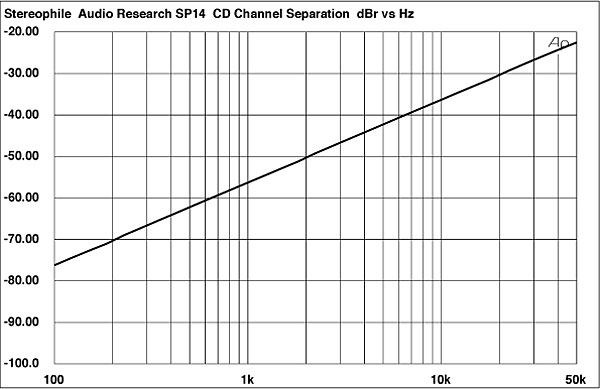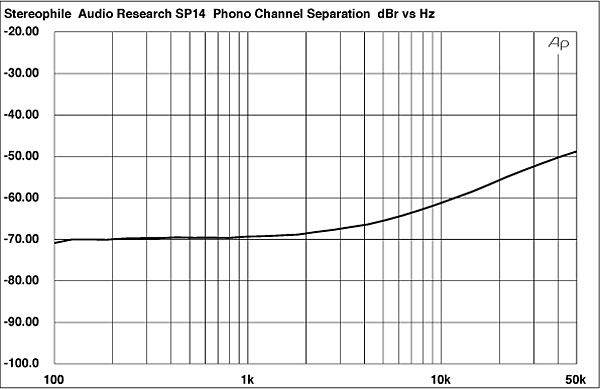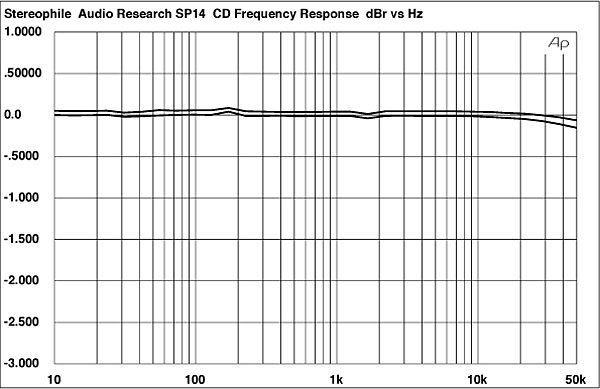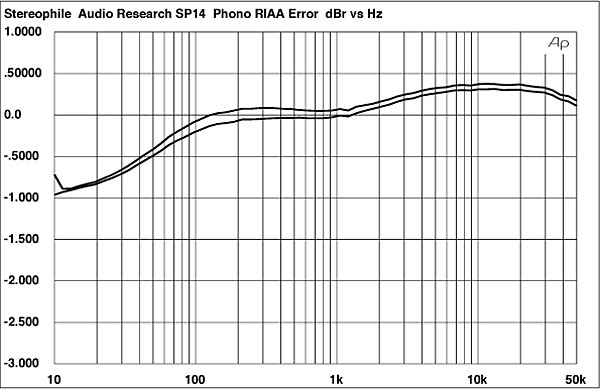| Columns Retired Columns & Blogs |
Audio Research SP14 preamplifier Measurements
Sidebar 3: Measurements
As there was only a short time available to do some measurements before this review had to be set in type, I therefore concentrated on a small number of parameters that Guy's auditioning suggested might be important. Guy had found the C-J PV9 to present a rather wider soundstage than the SP14. Accordingly, I looked at channel separation of the ARC unit.
Fig.1 shows the crosstalk from the left into the right channel, measured at the main right output with a 1V input signal applied to the left CD input. (The right input was loaded with 25 ohms, the attenuation control was set to 0dB, the gain control to 12 o'clock, and the bypass switch was operative). Although separation is respectable below 1kHz, it rises regularly with frequency to a barely adequate 30dB at 20kHz. The shape of the curve suggests capacitive coupling between the channels, perhaps due to the volume and attenuation controls, or to the line-stage circuitry itself. Switching the bypass switch off worsened these figures by 2dB or so, and the leakage from the right into the left channel was identical. So, also, was the measured separation when measured at the main outputs with an RIAA-preemphasized signal fed into the phono inputs. Looking at the separation of just the phono stage measured at one of the pairs of tape outputs, however, gave the curve in fig.2. The crosstalk below 2kHz or so is below the noise floor, and is generally 25dB lower down in the treble. This confirms the idea that the volume controls and line stage are responsible for the reduced separation.

Fig.1 Audio Research SP14, L–R crosstalk on CD input, measured at main outputs. (Input level 1V, Attenuation = 0dB, V/C = 12:00, Bypass In, 5dB/vertical div.)

Fig.2 Audio Research SP14, L–R crosstalk on phono input, measured at Tape 1 outputs. (Input level 10mV at 1kHz, signal RIAA preemphaszied, measurement dominated by noise below 2kHz, 5dB/vertical div.).
Turning to the SP14's frequency responses, fig.3 shows that measured via the CD input, which is respectably flat across the band, though the left channel has a slightly higher gain than the right. Via the phono input, and measured at the tape outputs, the RIAA error is similar for both channels, reaching a maximum of +0.38dB at 11.5kHz and drooping by almost 1dB by the time it reaches 10Hz. I would expect this to be audible as a slight lack of impact to the bass, coupled, not with brightness per se, but with a heightened sense of detail or life in the treble.

Fig.3 Audio Research SP14, CD input frequency response, V/C set to unity gain (0.5dB/vertical div.)

Fig.4 Audio Research SP14, phono input frequency response, measured at Tape 1 outputs (0.5dB/vertical div.)
All other aspects of the SP14 seemed to be to specification, including gain structure, noise, and overload. The volume control tracking was excellent, being within ± 0.1dB from full volume to the 9 o'clock position, below which the maximum inter-channel error was still just 0.37dB. (The steps themselves varied from below 1dB above 2 o'clock, to 2–3dB between 11 o'clock and 9 o'clock, increasing to 5–8dB below that position.) The output impedance measured as being 205 ohms at 1kHz from the main outputs and 1010 ohms from the tape outputs. Long or highly capacitive cables should not present a problem, therefore.—John Atkinson
- Log in or register to post comments




































